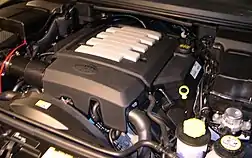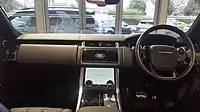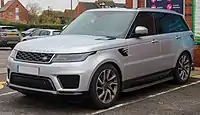Range Rover Sport
The Range Rover Sport is a British luxury mid-size SUV made by Land Rover. The first generation (codename: L320) started production in 2005, and was replaced by the second generation Sport (codename: L494) in 2013.
| Range Rover Sport | |
|---|---|
 | |
| Overview | |
| Manufacturer | Land Rover |
| Production | 2005–present |
| Assembly | Land Rover's Solihull plant, United Kingdom |
| Designer | Gerry McGovern |
| Body and chassis | |
| Class | Mid-size luxury SUV |
Range Stormer concept



The Range Rover Sport was prefigured by the Range Stormer concept car, introduced at the 2004 North American International Auto Show. This was a low-slung, short wheelbase 3-door coupè that was unusually "sporty" in the context of Land Rover's history.[1] Designed by Richard Woolley, the marque's first complete concept car sported split-folding gullwing doors, one-piece skeletal seats, a "clamshell" hood, 22 inch alloys, a 289 km/h (180 mph) top speed, 4WD and a 2,500 kg (5,512 lb) weight. The Range Rover Sport was comparably of much more conservative design featuring five doors and a wheelbase hardly shorter than that of the Range Rover Vogue. A replica of the Stormer was built by West Coast Customs of Corona, CA for Sheikh Hamdan bin Mohammed Al Maktoum, Crown Prince of Dubai, on the occasion of opening West Coast Customs Dubai; the car is currently registered under the Dubai Traffic And Road Authority.
The Range Stormer is now on display at the Heritage Motor Centre in Gaydon, Warwickshire, UK.
First generation (L320; 2005–2013)
| First generation (L320) | |
|---|---|
.jpg.webp) | |
| Overview | |
| Production | 2005–2013 |
| Assembly | United Kingdom: Solihull (Solihull plant) |
| Body and chassis | |
| Layout | Front-engine, all-wheel drive |
| Related | Land Rover Discovery (L319) |
| Powertrain | |
| Engine | Petrol engines: 4.2 L Supercharged Jaguar AJ-V8 4.4 L Jaguar AJ-V8 5.0 L Jaguar AJ-V8 5.0 L Supercharged Jaguar AJ-V8 Diesel engines: 2.7 L Ford Lion V6 3.0 L Ford Lion V6 3.6 L Ford Lion V8 |
| Transmission | 8-speed automatic 6-speed ZF automatic 6-speed ZF HP28 automatic |
| Dimensions | |
| Wheelbase | 108.1 in (2,745 mm) |
| Length | 2005–2009: 186.5 in (4,737 mm) Since 2009: 188.3 in (4,783 mm) |
| Width | 2005–2009: 75.9 in (1,928 mm) Since 2009: 76.1 in (1,933 mm) |
| Height | 71.5 in (1,816 mm) |
Chassis
The chassis has been adapted from the integrated bodyframe, semi-monocoque, independently suspended design which debuted on the Discovery 3 in 2004. This allegedly gives the Range Rover Sport the refinement and structural rigidity advantages of a monocoque chassis with the robustness of a separate chassis design for off-road applications. It also allows for less expensive manufacturing of the vehicles due to a large number of common components. Although sitting on a modified version of the Discovery 3's chassis, it is smaller than its more utilitarian sibling in every dimension with a wheelbase shorter by 140 mm (5.5 in). Its smaller dimensions and its raked roofline make it impossible to accommodate third-row occupants like the Discovery 3, but as a sports tourer it was never intended to be a seven-seater. Brembo front brakes are standard on all models except the TDV6.
Powertrain

The 2010-2013 Range Rover Sport HSE is powered by a naturally aspirated 5.0-litre all-aluminium Jaguar AJ-V8 engine producing 370 hp (276 kW) and 510 N⋅m (376 lbf⋅ft), with a supercharged 5.0-liter variant producing 510 hp (380 kW) and 550 N⋅m (406 lbf⋅ft). The 2005-2009 Range Rover Sport HSE is powered by a naturally aspirated 4.4-litre Jaguar AJ-V8 engine producing 300 hp (224 kW) and 425 N⋅m (313 lb⋅ft), with a supercharged 4.2-liter variant producing 385 hp (287 kW) and 550 N⋅m (406 lbf⋅ft).. Both petrol engines have been designed with a sump and oil pick-up system to allow for operation at extreme angles. Due to lack of popularity, the naturally aspirated power plant was omitted from the UK market in 2007. The advanced 2.7-litre turbodiesel TDV6 is an adaptation of the PSA/Ford development and produces 190 hp (142 kW) and 440 N⋅m (325 lbf⋅ft) in Land Rover guise. It features a compacted graphite iron block and aluminium cylinder head with fast switching piezo crystal injectors. Debuting in both the Sport and the flagship Range Rover in 2007 was the 3.6-litre twin turbodiesel TDV8. This engine is a further adaptation of the TDV6 but features a 90 degree block (as opposed to a 60 degree layout), twin variable geometry turbochargers and inlet valve deactivation. All engine variants are mated to an adaptive six-speed ZF 6HP transmission(ZF6HP26) ZF automatic transmission, except the SDV6, which received the ZF 8HP transmission(ZF8HP70). These gearboxes has a unique mode: CommandShift which reacts and adapts to varying driving styles. CommandShift gives the driver the freedom to sequentially manipulate gear changes.
| Years | Model & transmission | Engine | Power | Torque | Top speed | 0-62 mph (0–100 km/h) | Economy | CO 2 emissions |
|---|---|---|---|---|---|---|---|---|
| Diesel | ||||||||
| 2005–2009 | 2.7 L TDV6 CommandShift | 2.7 L, V6 turbodiesel | 190 PS (140 kW; 187 hp) | 440 N⋅m (325 lbf⋅ft) | 120 mph (193 km/h) | 11.9 s | 28.2 mpg‑imp (10.0 L/100 km; 23.5 mpg‑US) | 265 g/km |
| 2010–2013 | 3.0 L TDV6 CommandShift | 3.0 L, V6 turbodiesel | 211 PS (155 kW; 208 hp) | 520 N⋅m (384 lbf⋅ft) | 120 mph (193 km/h) | 10.3 s | 33.2 mpg‑imp (8.5 L/100 km; 27.6 mpg‑US) | 224 g/km |
| 2007–2010 | 3.6 L TDV8 CommandShift | 3.6 L, V8 twin-turbodiesel | 272 PS (200 kW; 268 hp) | 640 N⋅m (472 lbf⋅ft) | 130 mph (209 km/h) | 8.6 s | 18.1 mpg‑imp (15.6 L/100 km; 15.1 mpg‑US) | 294 g/km |
| 2011–2013 | 3.0 L SDV6 CommandShift | 3.0 L, V6 twin-turbodiesel | 258 PS (190 kW; 254 hp) | 600 N⋅m (443 lbf⋅ft) | 124 mph (200 km/h) | 8.9 s | 25.4 mpg‑imp (11.1 L/100 km; 21.1 mpg‑US) | 230 g/km |
| Petrol | ||||||||
| 2005–2009 | 4.4 L V8 CommandShift | 4.4 L, V8 | 300 PS (221 kW; 296 hp) | 425 N⋅m (313 lbf⋅ft) | 130 mph (209 km/h) | 8.2 s | 19.0 mpg‑imp (14.9 L/100 km; 15.8 mpg‑US) | 352 g/km |
| 2005–2009 | 4.2 L V8 CommandShift[2] | 4.2 L, V8 supercharged | 390 PS (287 kW; 385 hp) | 550 N⋅m (410 lbf⋅ft) | 130 mph (209 km/h) | 7.1 s | 18.0 mpg‑imp (15.7 L/100 km; 15.0 mpg‑US) | 327 g/km |
| 2010–2013 | 5.0 L V8 CommandShift | 5.0 L, V8 | 375 PS (276 kW; 370 hp) | 510 N⋅m (376 lbf⋅ft) | 130 mph (209 km/h) | 7.3 s | 20.3 mpg‑imp (13.9 L/100 km; 16.9 mpg‑US) | 327 g/km |
| 2010–2013 | 5.0L V8 CommandShift | 5.0 L, V8 supercharged | 510 PS (375 kW; 503 hp) | 550 N⋅m (406 lbf⋅ft) | 140 mph (225 km/h) | 5.9 s | 17.8 mpg‑imp (15.9 L/100 km; 14.8 mpg‑US) | 374 g/km |
Suspension
Air suspension, as standard, gives the driver the option of three ride height settings including a standard ride height of 172 mm (6.8 in), an off-road height of 227 mm (8.9 in) and a lowered access mode. There is also an extra height available which is accessed by holding the respective button for when the off-road ride height is not enough. When the vehicle bellies out, its control system will sense weight being lessened on the air springs and the ride height is automatically raised to the suspensions greatest articulation. The cross-link aspect of the suspension system, which debuted on the L322 Range Rover in 2002, results in better off-road performance by electronically operating valves in pneumatic lines which link adjacent air springs. In the event of a wheel on one side being raised when travelling off-road, the pneumatic valves are opened and the adjacent wheel is forced down, simulating the action of a live axle setup.
Terrain Response
_TDV6_wagon_(2015-12-07)_02.jpg.webp)
Land Rover's patented Terrain Response system which debuted on the Discovery 3 is fitted as standard on all models. Terrain Response allows the driver to adjust chassis and transmission settings to suit the terrain being traversed. Five settings are available via a rotary knob on the centre console. These include general driving; grass, gravel, snow; mud and ruts; sand; and rock crawl. Suspension ride height, engine management, throttle mapping, transfer case ranges, transmission settings, electronic driving aids (such as electronic traction control (ETC), dynamic stability control (DSC) and hill descent control (HDC)) and electronic e-diffs are all manipulated through the Terrain Response system.[3] All Range Rover Sports are equipped with a standard centre e-diff from Magna Steyr Powertrain which electronically locks and unlocks and apportions torque via means of a multi-plate clutch pack located in the transfer case which also offers ‘shift-on-the-move’ dual-range operation.[4] A rear e-diff is optional on all Range Rover Sport models and is able to lock and unlock instantaneously. An in-dash display is available which, among other things, is linked to Terrain Response and displays important off-road information such as the status of the e-diffs, the angle of the steering and wheel articulation. It is also able to inform the driver of wheels which do not have contact with the ground.
Driving technologies
Dynamic Response incorporates electrohydraulic active anti-roll bars which react to cornering forces and activate and deactivate accordingly resulting in sublime on-road handling. Dynamic Response also aids off-road performance by decoupling the anti-sway bars to allow maximum wheel articulation. The system in an evolution of the acclaimed ACE (Active Cornering Enhancement) system available on the Discovery Series II but is described as proactive rather than reactive. Positive Torque, a system standard on all TDV8 and Supercharged models, electronically blips the throttle, resulting in faster downshifts and the availability of vast reserves of torque. The speed sensitive steering system, adopted from Jaguar is standard on all models and there's the option of active bi-xenon headlamps which act with the angle of the steering to aid vision. Active Cruise Control (ACC) with Forward Alert system incorporates an integrated front bumper radar which detects vehicles travelling ahead and adapts the vehicle's speed to match. The system scans the road ten times a second, has a 16 degree field of view and Land Rover claims it is able to discriminate between a heavy vehicle and an adjacent lane motorcycle travelling at least 180 metres (590 ft) ahead.[5] Four preset distances are selectable and will ensure the Sport maintains the desired distance from the vehicle it is following.
Safety
The NCWR organisation (New Car Whiplash Ratings) tested the Range Rover Sport in 2010 and awarded it the following scores:[6]
| NCWR | Score |
|---|---|
| Geometric: | G |
| Dynamic: | A |
| Overall: | A |
G = Good, A = Acceptable, M = Marginal, P = Poor
Security
The Range Rover Sport was tested by Thatcham's New Vehicle Security Ratings (NVSR) organisation and achieved the following ratings:[7]
| NVSR | Rating |
|---|---|
| Theft of car: | |
| Theft from car: |
Facelift (2009)
_%E2%80%93_Frontansicht%252C_5._September_2012%252C_Wuppertal.jpg.webp)
_%E2%80%93_Heckansicht%252C_5._September_2012%252C_Wuppertal.jpg.webp)
_SDV6_HSE_Luxury_wagon_(2012-10-26)_02.jpg.webp)
A facelifted model was first shown at the New York Auto Show in April 2009. The 2010 Range Rover Sport featured a more aerodynamic front-end including new headlights, grille and bumper. Also new are revised rear lights and rear bumper. Interior revisions are more significant with a new fascia, steering wheel, door linings, seats, instruments and switchgear. The new model has more leather apparent and nearly 50 percent fewer dash board buttons than the previous model. Three new engines made their debut in the 2010 Sport. These include an all-new direct injected, all-aluminium 5.0-litre petrol V8 engine in naturally aspirated and supercharged guises as seen in Jaguar's latest range of high-performance vehicles. The naturally aspirated model produces 375 hp (280 kW) and 375 lb⋅ft (508 N⋅m) torque while the supercharged produces 510 hp (380 kW) and 461 lb⋅ft (625 N⋅m) torque. Also new is a heavily revised 3.0-litre version of the current 2.7-litre TDV6 producing 180 kW (241 hp) and 600 N⋅m (443 lbf⋅ft), adapted from Jaguar's AJ-V6D Gen III. This engine features parallel sequential turbochargers - a single variable geometry turbocharger and a single fixed geometry turbocharger which is only active when required as seen on the Jaguar XF Diesel S. All of the new engines produce increased power and torque over their predecessors while delivering better fuel economy and reduced CO
2 emissions. Fitted with a sixth generation twin-vortex supercharger with an improved thermodynamic efficiency of 16 percent, the new 5.0-litre supercharged engine produces 29 percent more power and 12 percent more torque than the current 4.2-litre engine, yet CO
2 emissions and fuel consumption are improved by 5.6 percent and 6.2 percent respectively. The new 3.0-litre TDV6 engine produces 29 percent more power and 36 percent more torque than the 2.7-litre engine, yet CO
2 emissions and fuel consumption are both improved by 9 percent. The 2010 model year Sport is also fitted with the new ZF HP28 six-speed automatic transmission. Designed to improve performance and efficiency, the new transmission engages the lock-up clutches of each gear earlier after selection. Suspension refinements also occurred with the introduction of the world's first production damping system using model-based predictive technology that continually optimise the settings of the new DampTronic Valve Technology damper units to optimise vehicle ride and control. Further improvements to the award-winning Terrain Response system have taken place for 2010. Revisions to the rock crawl program reduce roll when traversing boulders delivering a more composed ride over rocky terrain. The addition of a new 'sand launch control' prevents wheels digging in when driving away in soft sand thanks to revisions to the traction control system. The Hill Descent Control system has also been enhanced with the addition of Gradient Release Control, which inhibits the initial rate of acceleration when descending steep inclines.
Facelift (2012)
A final facelift to the L320 platform came in MY12 introducing minor changes. The interior remained largely the same however features such as an electric power tailgate and revised media interface featuring bluetooth audio streaming where added. There was also the addition of the ZF 8 speed automatic transmission and accompanying rotary wheel gear selector.
Controversy
The Range Rover Sport made Ford's Premier Automotive Group the target of a protest by Greenpeace in 2005.[8] The protesters infiltrated an assembly facility and temporarily delayed production of the vehicle. Greenpeace cited issues with greenhouse gas emissions, and by extension, global warming. The United States Environmental Protection Agency estimates for the non-supercharged car are 14 mpg‑US (17 L/100 km; 17 mpg‑imp) (combined). Although for this test the EPA used their newly calibrated system for 2008 and on. Greenpeace stated they did not take issue with the production of vehicles such as the Land Rover Defender as they are typically used for off-road applications on a much more frequent basis than vehicles such as the Range Rover Sport which they claim "has been tuned primarily for on road performance".[8]
Second generation (L494; 2013–present)
| Second generation (L494) | |
|---|---|
_HSE_SDV6_wagon_(2018-08-31)_01.jpg.webp) | |
| Overview | |
| Production | 2013–present[9] |
| Assembly | United Kingdom: Solihull (Solihull plant) |
| Designer | Gerry McGovern |
| Body and chassis | |
| Platform | JLR D7u[10] |
| Related | |
| Powertrain | |
| Engine |
|
| Electric motor |
|
| Transmission | 8-speed automatic (ZF 8HP) |
| Battery | 13.1 kWh Lithium ion (PHEV) |
| Dimensions | |
| Wheelbase | 115.1 in (2,923.5 mm)[9] |
| Length | 191 in (4,851.4 mm)[9] |
| Width | 81.6 in (2,072.6 mm) (mirrors folded) [9] |
| Height | 71.3 in (1,811.0 mm) |
| Kerb weight | 4,727 lb (2,144.1 kg)[9] |
_HSE_SDV6_wagon_(2018-08-31)_02.jpg.webp)

The second-generation Range Rover Sport was announced on 27 March 2013 at the New York Auto Show. Several streets were shut down in Manhattan for a launch party at the Auto Show starring James Bond actor Daniel Craig.[12]
Design
The new Range Rover Sport continues in the design direction that produced the Evoque styling, and the full-size 2013 Range Rover. It is 4 inches (100 mm) longer, being 191 inches (4,851 mm) long; and 400 lb (181 kg) lighter, weighing in at 4,727 lb (2,144 kg). Unlike the previous generation that uses an integrated bodyframe chassis, the L494 Range Rover Sport utilizes an all-aluminium monocoque body, just like the L405 Range Rover.
It introduced Dynamic Response suspension with active anti-roll bars.
SVR (2015 Pre-Facelift)

_-_Land_Rover_RANGE_ROVER_SPORT_SVR_(L494).JPG.webp)
On 11 August 2014, the Range Rover SVR (Special Vehicle Racing) was announced by Land Rover at Pebble Beach. The model sports a number of aesthetic alterations and performance improvements.[13]
The design of the model features a fully revised front bumper, with larger ducts and the main grille finished in black. The front quarter ducts are also revised and completed in a black finish. The rear bumper is also completely revised with a new, more pronounced diffuser and twin-circle exhaust tips. The SVR comes with 21 inch alloy wheels, wrapped in 275/45 R21 all-season tyres as standard.
Performance upgrades for the SVR including the 5.0L supercharged V8 shared with the Jaguar F-Type, with a power output of 550 hp (410 kW) and torque output of 502 lb⋅ft (681 N⋅m) the transmission has been programmed to shift 50% quicker and to keep the torque converter locked up once it is in second gear. The chassis had also been revised for the model. Debut of Adaptive Dynamics with Magnetorheological dampers. New for the SVR is the addition of an Active exhaust system with electronically controlled valves. The improvements make the SVR capable of 0-60 mph (97 km/h) in 4.5 seconds and a top speed of 162 mph (261 km/h),[11] one of the quickest of its type.[14]
SVR (2018 Facelift)
In 2017 at the LA Auto Show, the facelifted Range Rover Sport SVR was announced by the Jaguar Land Rover Group. This facelifted model includes all of the same features that the 2018 Range Rover Sport has, but the SVR has upgraded body styling which includes the all new Silver Quad Exhausts and with the all new option of a Carbon Fibre hood. The 2018 SVR still includes the same 5.0L Supercharged V8 from the Jaguar F-Type, but the engine now produces 575 hp (429 kW) instead of the pre-facelift's 550 hp (410 kW), allowing the SVR to accelerate from 0-60 mph (97 km/h) in 4 seconds.
Due to its large size and poor environmental record, Environmental Action Germany nominated the Range Rover Sport SVR for their Goldener Geier (Golden Vulture) 2020 award.[15]
Facelift
In 2017, at the Los Angeles Car Show, the Jaguar Land Rover Group announced the facelifted Range Rover Sport would begin production in 2018. The new Sport features new headlights, a new interior with the touch duo system and a MHEV 355 and 395 HP as well as a V8 with 518 HP and the SVR version with 575 HP. The main changes in the facelift are redesigned front and rear bumpers, new exhausts (two black pipes on S & SE variants, twin silver pipes on HSE, HSE Dynamic and Autobiography with Dynamic Pack and Quad exhausts on the SVR Variant) and upgraded touch duo infotainment from the 2018 Range Rover Velar.
 2017 facelift
2017 facelift 2017 facelift
2017 facelift
Worldwide sales
| Year | Sales |
|---|---|
| 2009 | 33,460 |
| 2010 | 46,096 |
| 2011 | 54,670 |
| 2012 | 56,832 |
| 2013 | 58,234 |
| 2014 | 82,440 |
| 2015 | 87,319 |
| 2016 | 87,758 |
| 2017 | 81,213 |
| 2018 | 77,847 |
| 2019 | 81,700 |
| Total | 747,569 |
References
- Gritzinger, B (19 January 2004). "And baby makes four: Range Stormer conceives sporty side of Land Rover". AutoWeek (54): 4.
- https://www.caranddriver.com/reviews/a18201827/2006-land-rover-range-rover-first-drive-review/
- "4×4 of the Year 2008", 4×4 Australia Magazine, January 2008
- "Disco 3 Centre Differential". Australian Land Rover Owners. Retrieved 27 July 2009.
- Range Rover Promotional DVD
- "Safety New Car Whiplash Ratings Car Search Thatcham MIRRC". Thatcham.org. Archived from the original on 29 September 2011. Retrieved 19 August 2011.
- | New Vehicle Security Ratings | Car Search | Car Results Archived 2 August 2011 at the Wayback Machine
- "Greenpeace shuts down Range Rover assembly line". Greenpeace UK. 16 May 2004. Archived from the original on 21 May 2008. Retrieved 27 July 2009.
- "Range Rover Sport: quicker, agile, and 800 pounds lighter". CSMonitor.com. Retrieved 27 March 2013.
- "Characterizing the Range Rover and Range Rover Sport using WAVE" (PDF). ricardo.com. January 2014. Retrieved 13 February 2015.
- "2015 Land Rover Range Rover Sport SVR". Seriouswheels.com. Retrieved 16 September 2014.
- "New Cars, Car Reviews, Car Prices and Auto Shows – MSN Autos". msn.com. Archived from the original on 11 April 2013.
- "Range Rover Sport SVR revealed at Pebble Beach". Autoexpress.co.uk". Retrieved 16 September 2014.
- Lieberman, Jonny. "Cayenne Turbo S vs. GLE63 S Coupe vs. X6 M vs. Range Rover Sport SVR" Motor Trend, 21 December 2015. Archive
- "Goldener Geier 2020" [Golden vuture 2020] (in German). Retrieved 29 June 2020.
- "Tata Motors - Investors - JLR Volumes". tatamotors.com. Archived from the original on 31 July 2017.
- https://www.statista.com/statistics/387780/land-rover-global-sales-by-model/